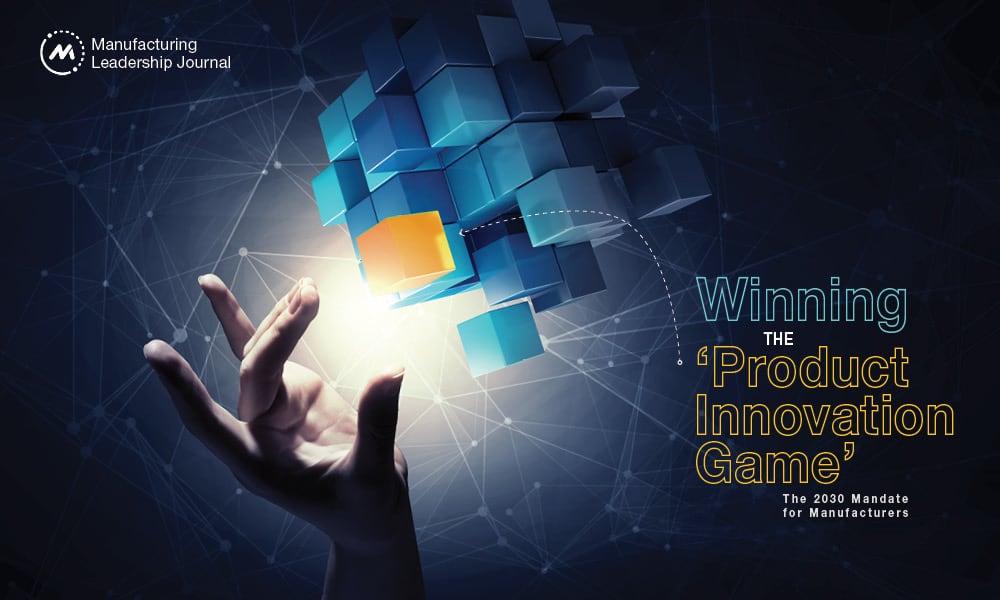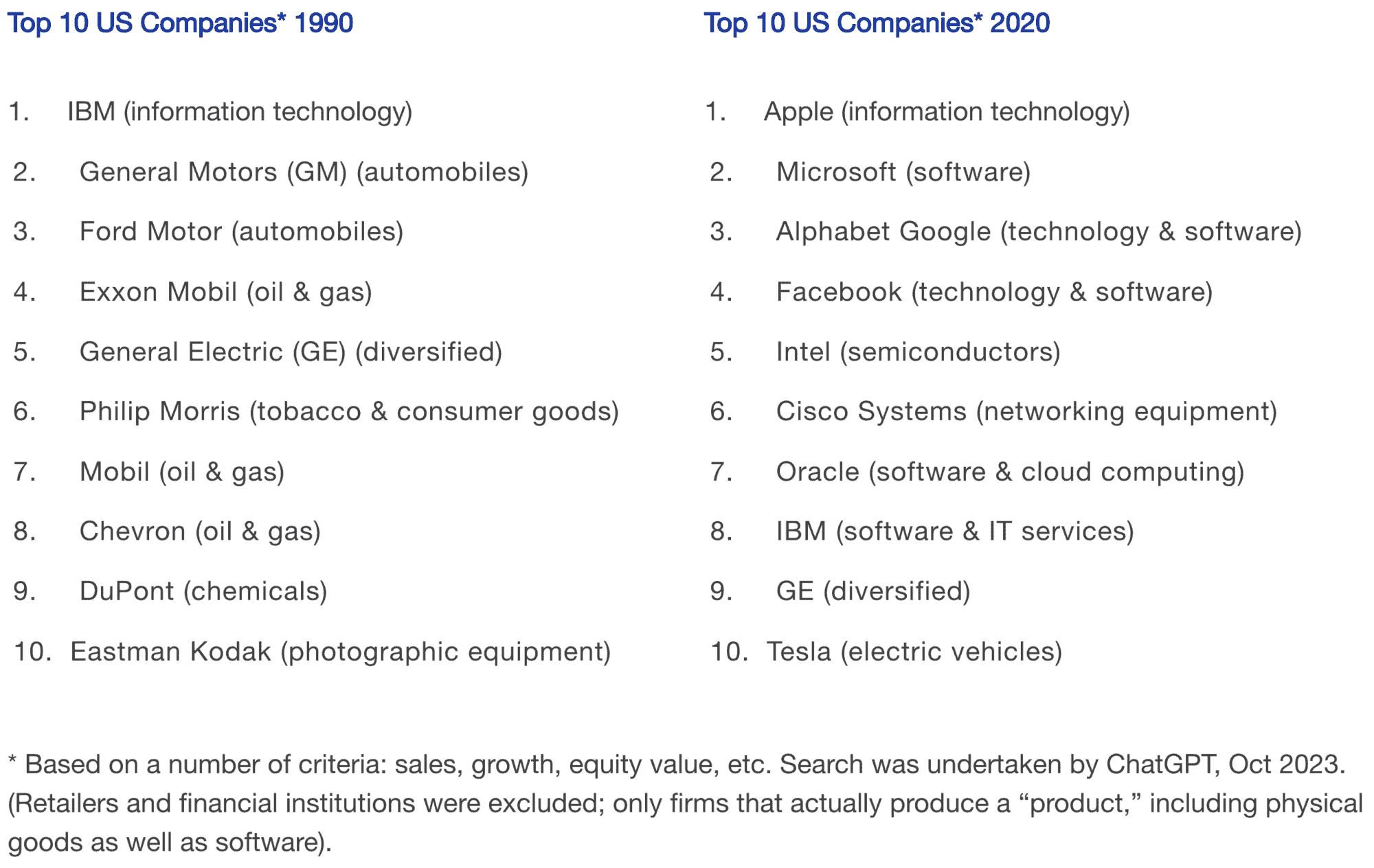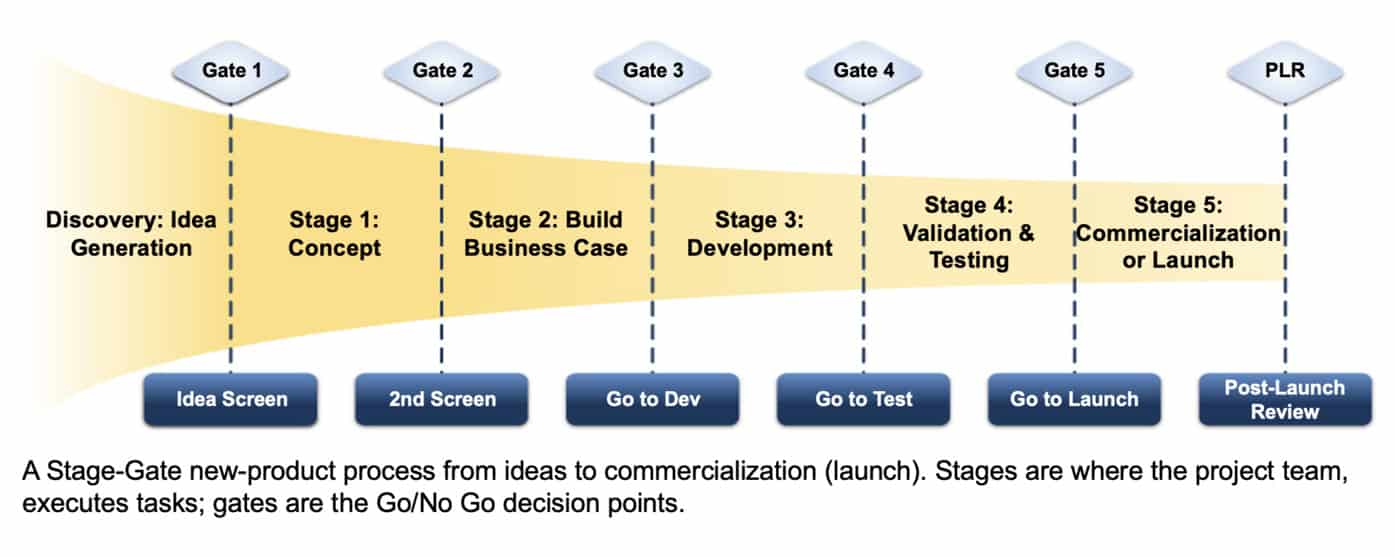Winning the ‘Product Innovation Game’: The 2030 Mandate for Manufacturers

To win at product innovation, manufacturers will need to make their NPD processes more robust by integrating Operations staff earlier and by using AI and other Industry 4.0 technologies.

TAKEAWAYS:
● To survive and prosper, manufacturers must strive to excel at product innovation.
● Manufacturers can use build-and-test iterations to validate new products technically and with customers. Build-and-test iterations can be done early, often, quickly, and cheaply.
● Artificial intelligence can be a game-changer in the new product development process.
Innovation propels companies to greatness! Consider the transformation in the list of top 10 companies in America over the past three decades. In 1990, all top 10 US firms were in traditional physical products industries (Table 1). Half were in oil and gas or petrochemicals. By 2020, only two of the 1990 top ten—IBM and GE—remain on the list, but further down.
Table 1: Top 10 US companies, 1990 vs. 2020

Two fundamental factors underlie this 30-year shift:
- A transition from manufacturing: Only half of the top 10 US firms in 2020 are manufacturers, while the product offerings of the top 10 firms has shifted from older technologies, such as oil and gas or traditional autos, to newer ones, such as IT and electric vehicles (EVs). Even individual companies like IBM, once renown for making computers, now predominantly offer software and services.
- An emphasis on successful product innovation: The newer entrants on the 2020 list, such as Apple, Microsoft, and Tesla, surged primarily due to successful product innovation. In contrast, companies that failed to innovate effectively were replaced. For instance, Kodak’s inability to adapt to disruptive innovation—namely, digital cameras—led to its downfall. Innovators like Tesla surged ahead with EVs, while GM fell behind, no longer on the top 10 list.
Innovation will remain the disruptive force moving forward to 2030, even more so than in the past. We now live in the Fourth Industrial Revolution driven by technologies such as artificial intelligence (AI) and machine learning, blockchain, and robotics and automation, which will create huge changes in industry, particularly in manufacturing.
Strategically, manufacturers must adopt some or all of these new technologies, and build them into their products and processes. A less visible but equally vital message is that manufacturers must strive to excel at product innovation in order to grow and prosper. Ironically, Kodak developed the first ever digital camera, but the company’s failure to successfully commercialize it ultimately led to its demise.

“Many firms’ NP processes are cumbersome and bulky—there’s too much bureaucracy and ‘non-value-added work.’”
Many manufacturers have a long way to go when it comes to successfully commercializing new products. New-product project success rates for physical product firms are now at 25–30 percent1,2—that is, less than one-third of new-product projects succeed commercially!
The Role of Operations in New Product Development (NPD)
How can Operations make a difference to the business’s pace of product innovation and its new product success rate?
Here are four ways:
1 Play new-product football*: A best practice—consistently found to be key to success—is that NPD is a cross-functional team effort.3 Operations/Manufacturing have often been left out of the new-product process. If included, they’re not on the field until near the end of the project, just before the final commercialization stage (Figure 1). This flawed process moves the ball down the field department by department—from Marketing to RD&E and finally to Operations and Sales. The term “transfer to the plant” too often typifies the final play from development to commercialization; a disconnect occurs. This process resembles a relay race, with the baton being passed from person to person (or department to department) with many dropped batons. And it is not the way to win at new products.
A truly cross-functional project team includes staff from all key departments—Marketing, RD&E, Operations, and Sales—and the project advances thanks to a team effort, much like a football team moves the ball, play by play, to the goal line. The process is typically a stage-and-gate new-product process like in Figure 1, where stages are the “plays” and gates are the Go/No Go decisions point or “huddles on the field.”4
Although there is often little work for the Operations members of the project team early in the project, they are still key contributors because their input, knowledge, and experience are crucial to success. They provide insights into
- Manufacturing feasibility (Can it be made?);
- Existence of core competencies (Can we make it?);
- Need for capital equipment, costs, and timing; and
- Likely manufacturing cost, source of supply risks, and resolution.
This information is vital to building a robust business case for a project, for making the right project selection decisions, and for ensuring a smoother, faster production startup in the commercialization stage.
Figure 1: Typical Stage-and-Gate New-Product Process

2 Making the right Go/Kill decisions: One way to improve new product success rates is picking the winners by making the best go/kill decisions. Besides being project team members early on and sharing important information, an important role for Operations senior management is to be at the Go/No Go meetings for projects (the gates). Gates are where NPD investment decisions are made, and where management decides which projects move forward. Project innovation is a business endeavor, not just the domain of Marketing and RD&E. Operations must have a clear voice at the investment decision table.
3 Accelerate the game—remove the waste: Today’s fast-paced world demands accelerated development. Many firms’ NP processes are cumbersome and bulky—there’s too much bureaucracy and “non-value-added work.” As a result, projects move at a crawl. Lean principles (Lean Six Sigma) were widely applied on the factory floor in the early part of this century, and Operations staff know the methodology well.
Operations can lead by example, helping the other business functions streamline the innovation process. Typically, value stream analysis is used to map the entire new-product process, idea to launch.4 Bottlenecks and time wasters get identified, and a root cause analysis is undertaken to determine why. Then time wasters are removed or reduced. It’s an effective method, used often in Operations, but it is not so well known by other functions. Some firms have applied this Lean methodology to NPD with quite dramatic results—up to 40–50 percent savings in time to market.4

“AI can also be used to facilitate portfolio management and project management. Within five years, predictive analytics may be making the Go/No Go decisions at gates.”
4 Be Agile in NPD: Everything changes quickly today: What was true in the early stages of the project is no longer true by the latter stages. A major unexpected challenge in NPD is that things have changed by the time the project reaches commercialization: the customers’ needs have shifted, a competitive product has been introduced, or product requirements are no longer valid. Instead of moving into production quickly, the project grinds to a halt, and it’s back to the drawing board. Late-stage changes in product design create huge costs and time delays.
A key principle of Agile development5 is being flexible and being able to pivot quickly—the product design is allowed to evolve as the project moves forward. Frozen design specs from the beginning of the development stage are a thing of the past. The goal is to get the get the product right pre-production. This agility concept is borrowed from Agile software development.
How? The project team undertakes a series of build-and-test iterations beginning before development, all the way to production startup.6 These build-and-test iterations validate the product both technically and with customers, early, often, fast, and cheaply. Built into each iteration are tests—technical tests as well as a demo to stakeholders (both customers and management). Negative feedback usually calls for a pivot in the project. If these iterations and pivots happen early and often, the cost and time of making changes is far less, and the product will be fully validated by the time it get to commercialization.
Some project teams fail to build these iterations into the process, especially the customer demos. Demos take time and money, and often involve a physical visit. (By contrast, in software development where Agile originated, demos can be done online.) Other teams wait until the product is almost developed before showing it to a customer. Smart teams, however, devise ways to test and demo non-existent products much earlier, and also undertake technical testing. Digital products, virtual products, computer animations, simulations, and AI tools are available to enable teams to show what the product will be, do, and look like long before a real prototype is ready to test.7 Regular build-and-test validations are much more feasible today thanks to new AI technology.
Operations people must be proactive on NPD projects, pushing hard to ensure that these build-and-text iterations are done; otherwise, odds are high that the product won’t be right when it gets to production startup. When that happens and product changes are needed as the project moves into commercialization, it becomes an “Operations problem.”
Build AI into your NPD System
Operations people have more experience with AI than RD&E, Marketing and Sales staff have. AI has impacted manufacturing in huge and very visible ways—for instance, optimizing the production process, process simulations, quality management, or managing the supply chain.8,9 Except for a handful of leading early-adopter firms like Siemens, Nestlé, and GE, AI has been much slower to penetrate the NPD process, however. As an early-AI-adopter, Operations can model the way and require that AI be pushed further upstream in the NPD process from the commercialization stage (Figure 1). Here are some examples:10,11
- AI in the Validation Stage: Digital twins mimic the product and can be used to monitor the real prototype product operating remotely during customer field trials. This dramatically improves test data quality, as well as reducing the time it takes for trials.12,13
- In Development: Development times can be cut in half by doing design and optimization iterations of product components digitally, as GE does in turbine design.14
- In the front end of the NPD process: AI can be used to scan many information sources looking for unmet needs and opportunities for new products, and can even generate new ideas and concepts.15 With simple verbal prompts, AI can create concepts and make concept drawings.16
AI can facilitate portfolio management and project management and thereby improve both on-time performance and success rates. Within five years, predictive analytics may be making the Go/No Go decisions at gates.
The Path Forward
Making product innovation work better and faster in your business this decade is imperative. But this is not a piece-meal effort—rather it should be an organization-wide initiative led by the leadership team. Operations must play a major role as you reshape your innovation process and methods in order to get it right—making it Lean and Agile, building in iterations for getting the product right, making the process truly cross-functional, and driving AI through the entire process. After all, it’s only the future of your company. M
References:
- Knudsen, M. P., von Pedowitz, M., Griffin, A., and Barczak, G. Best practices in new product development and innovation: Results from PDMA’s 2021 global survey. Journal of Product Innovation Management 2023;40;257–275.
- Barczak, G., Griffin, A., and Kahn, K. B. Trends and Drivers of success in NPD practices: Results of the 2003 PDMA Best Practices Study. Journal of Product Innovation Management 2009;26:93–23.
- Cooper, R. G. New Products: What Separates the Winners from the Losers and What Drives Success. In The PDMA Handbook of Innovation and New Product Development, 4th, edited by Ludwig Bstieler and Charles H. Noble, 3–43. Hoboken, NJ: Wiley. 2023.
- Cooper, R. G. The 5-th generation Stage-Gate idea-to-launch process. IEEE Engineering Management Review. 2022; 41(1):43–55.
- Beck, K., Beedle, M., van Bennekum, A. et al. Manifesto for Agile Software Development.
- Cooper, R. G., and Fürst, P. Agile Development for Manufacturers: The Emergent Gating Model. InnovationManagemenSE, Nov 10, 2020.
- Bilgram, V., and Laarmann, F. Generating Innovation with Generative AI: AI Augmented Digital Prototyping and Innovation Methods. IEEE Engineering Management Review. June 2023;51(2):18–25.
- Marr, B. The Future Of Manufacturing: Generative AI And Beyond. Forbes, July 25, 2023.
- D’Silva, V.,and Lawler, B. What Makes a Company Successful at Using AI? Harvard Business Review, Feb. 28, 2022.
- Cooper, R. G. The Artificial Intelligence Revolution in New-Product Development. [PDF] 2023.
- Cooper, R. G. The Artificial Intelligence Revolution in New-Product Development. YouTube video, 18:37.
- Huang, S., Wang, G., Lei, D., and Yan, Y. Toward digital validation for rapid product development based on Digital Twins: A framework.The International Journal Advanced Manufacturing Technology 2022;119:2509–2523.
- Nieto-Rodriguez, A., and Vargas, R. V. How AI Will Transform Project Management. Harvard Business Review, Feb. 2, 2023. https://hbr.org/2023/02/how-ai-will-transform-project-management
- Bogaisky, J. GE Says It’s Leveraging Artificial Intelligence To Cut Product Design Times In Half. Forbes, March 6, 2019.
- Applied Marketing Science. Our Solutions: Your Insights Partner. 2023.
- Roch, J. From Hot Wheels to handling content: How brands are using Microsoft AI to be more productive and imaginative. Microsoft News, Oct. 12, 2022.
About the author:

Robert G. Cooper is ISBM Distinguished Research Fellow at Pennsylvania State University’s Smeal College of Business Administration, Professor Emeritus at McMaster University’s DeGroote School of Business (Canada), and a Crawford Fellow of the Product Development and Management Association.
* North American football.